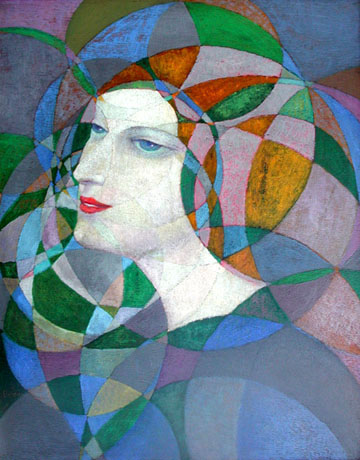

BOLESLAS BIEGAS
"TETE DE FEMME"
OIL ON PANEL, SIGNED
POLISH, WORKED IN PARIS, C.1925
CLICK HERE TO SEE RECENTLY ACQUIRED PAINTINGS
Boleslas Biegas was the son of an orchestra leader. After the death of his parents in 1890 he worked as a carpenter's assistant, a messenger, and then became an apprentice at the studio of Panusiak, a sculptor. He studied and worked with Panusiak for eighteen months. The experience gave birth to an artistic consciousness in Biegas and in 1896 he exhibited a group of sculptures in a bookstore in
Warsaw. His talent was evident, and in the same year he entered the Academy of Fine Arts of Cracow, studied in the studio of Daun, and then with Laszko. In the following years and for twenty years afterwards, he exhibited his works at the Societe d'Encouragement des Fine Arts of Cracow. In about 1900 he met Wyspianski who introduced him to painting and after a misunderstanding with his professors he left Cracow in 1901. He obtained a scholarship to continue his studies in Paris. He moved to Montparnasse and in 1902 he exhibited at the “Salon National des Beaux-Arts.” In that year, in Cracow, he published his first dramatic comedy Le passe et l'avenir.
In 1902 it was Biegas that gave birth to circular forms in painting. His Cycle des Tableaux Spheriques is and example of this new style. Biegas's works of this period strongly impressed Robert Delaunay. It is interesting to note that this was five years before Picasso invented what was called cubism. Even later many of the Futurists utilized the technique of circular forms in many of their works.
Also in 1902 his sculptures were published in Editions de la Plume, an important art publication of the period. In 1903 he exhibited in Saint Petersburg. In the following year he published a philosophical essay, in Cracow, under the title “Peregrination de la pensee.” In 1905 he returned to exhibit in Warsaw his most recent works in painting and sculpture, and he published a drama Graczek which included a large number of his illustrations. Then in 1906 he published two new dramas Le chein de Berger and Lechit, after which he returned to Paris to participate in the Salon des Independants. An album dedicated to Biegas, with articles by some of the most important writers of the time, was published by Louis Theuveny.
In 1907 there occurred the first showing of Cycle de la Mystique d'infini sometimes known as Chateaux Mysterieux and Tableaux Bleus. Biegas painted in this style in 1909, 1927, 1937 and 1943. He painted in different styles in the years in between. There seems to be clearly, three or four very different styles that appear in his career, there are spherical forms, symbolists chateaus, symbolist creatures, and portraits.
He wrote a new book in 1908 titled Orfida, and painted a group of works called Cycle des Tableaux Divers. In 1909 he had a new exposition at Kulikowski's studio in Warsaw where he presented sculptures and paintings and published Bramir a book of dramas. In 1910 he returned to Paris at the Salon d'Automne, and in the following year he traveled to Rome and to Amsterdam for their international expositions of art. He also exhibited his original works in his own studio on the Rue de Bagneux, in Paris. He undertook his Cycle de Vampires de Guerre in 1913 to be exhibited at the Palace of Count Potocki on the Avenue de Freidland, which today is the Chamber of Commerce of Paris. His Cycle des Portraits d'home Illustres, also known as “Portraits Bleus” was done in 1919 the year that he again exhibited at the “Salon d'Automne.”
From 1920 to 1923 he returned to the “Salon des Independants,” and in 1925 he exhibited at the Galerie Andre Seligmann where there was a catalogue published with a preface by Gustave Kahn. He exhibited at the Salon d'Automne for the next ten years. He stopped sculpting in 1927 to start a new cycle, La Mystique d'Infini, and exhibited at Berheim Jeune in 1929. There was a group exhibition “Polish Art and Artists,” on the Avenue Montaigne in which he took part in 1931. In 1937 he edited the drama Saturne in Varsovie, and during the 1940's he painted his Cycle de Portraits et de Nations.
Biegas died in 1954 and left all of his works to the Bibliotheque Polonaise de Paris. Biegas the writer, painter, and sculptor enjoyed a long and successful career. He carried with him, throughout the years, his different styles and techniques. It is interesting to note the dates of his works, and that he never left behind a style that worked for him.